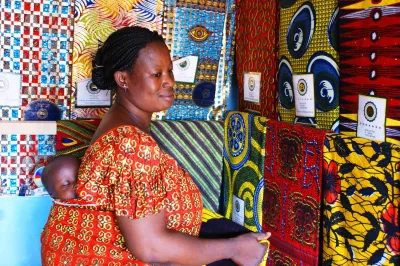Financial Inclusion 2.0: Generating New Evidence to Maximize Impact
Despite years of research on the impact of financial inclusion, the sector still lacks a comprehensive understanding of what works, when, and for whom. The existing body of evidence has produced mixed results, depending on the financial service features, its delivery method, and the context in which such services were offered.
Microcredit, in particular, has been the subject of extensive research and debate, with numerous success stories and failures alike. From the struggles of Nuoy and Nangkek, a young Cambodian farming couple trapped in a cycle of debt, to the aspirations of Rwandan entrepreneur Jacqueline Mukacyemayire, who took several loans to invest in her thriving business which employs 15 people full-time, these stories highlight the diverse impact of microcredit.
Rigorous impact studies including randomized controlled trials (RCTs) have also showcased diverging conclusions. For instance, a study from Hyderabad, India found that on average, microcredit had no discernible immediate or longer-term impact on women’s economic empowerment, health, or education. In contrast, a study from Bosnia and Herzegovina suggested that, while overall impacts were quite positive, some households may have experienced reduced consumption due to over-indebtedness. On the positive front, multiple studies, such as one from Mongolia, have shown positive effects on female entrepreneurship and household food consumption. These examples show the need for additional research to better understand the factors contributing to such wide-ranging results.
Existing evidence falls short of providing the type of nuanced insights necessary for stakeholders
The limitations of available rigorous studies in explaining the factors driving the diverse impacts of microcredit are true for the broader financial services market as well and have led to two main challenges. First, it has enabled both proponents and critics to selectively cite rigorous studies that bolster their arguments, as CGAP described in a previous blog. Second, and more importantly, these limitations have resulted in a lack of clear guidance for stakeholders such as funders, financial services providers, and policymakers to design appropriate strategies, programs, and interventions. For example, in the case of credit, many factors could determine how impactful such products are, including specific features such as interest rate and maturity, but also how the product is delivered, and if it is accompanied by complementary non-financial services such as business management training, general financial education, and other similar support services for customers. However, existing evidence falls short of providing the type of nuanced insights necessary for stakeholders, such as funders and financial service providers, to make well-informed decisions. That’s why we need new research to provide such insights, enabling prioritization of efforts that yield the greatest positive outcomes for customers and advance key development goals.
Data on customer outcomes and their financial transactions are becoming digitalized and more widely available, while innovative research methodologies are opening up exciting opportunities to generate the type of evidence we need to understand why the impact of financial services is so diverse.We are working toward this goal in four different ways.
1. Exploring how past microcredit impact studies can reveal insights into the contextual factors that influence outcomes for different types of customers
We are doing this through a wide consultative process with evaluation method experts. By compiling the original data from multiple existing impact studies, we are exploring why certain customer groups benefit more from microcredit than others, addressing the issue of limited observations in individual studies. This exercise is inspired by Rachael Meager’s 2022 paper, building on it by considering a larger number of recent studies that capture relevant outcomes and contextual variables and explore with greater granularity the factors that explain differences in impact across various customer segments. This exercise also aims to inform how future rigorous impact studies can be better designed to generate the evidence needed to understand which financial services work, for whom, and under what circumstances. Insights uncovered will be relevant for decision-makers designing financial inclusion strategies, programs, and interventions, and future impact research agendas.
2. Looking at innovative evaluation methodologies that leverage the growing availability of customer data
Using customer data captured by both financial service providers and government entities, such as central banks, we aim to assess the validity and usefulness of alternative evaluation methodologies in shedding light on the diverse impacts of financial services. For example, an area that shows promise is machine learning aimed at exploring causal or explanatory mechanisms, and other AI applications that may help identify what financial services work, when, and for whom. CGAP is establishing partnerships with visionary financial service providers and central banks embarking on open data and open finance schemes that possess a significant amount of relevant data on customer outcomes and their financial transactions (i.e., demand and supply-side data). CGAP will use these data to test the validity of new methods and compare their results with the more established impact analysis methods. Throughout, we will explore any biases and shortcomings that these methods may imply. Furthermore, our aspiration is to develop guidance on how such alternative methods can be replicated by others in the sector in the future as a complement to more traditional RCTs and enrich the analysis of impact.
3. Conducting a comprehensive review of the impact literature
Our aim here is to understand what the literature tells us about the ways financial services (including credit, savings, insurance, and payments) can contribute to important development outcomes, including resilience, climate change mitigation and adaptation, food security and nutrition, and women's economic empowerment, among others. This builds on previous work done by CGAP focused on contribution pathways for the impact of financial services on individual customers. The goal is to build an interactive tool that can be used for decision-making. It will indicate the strength of evidence behind each pathway, serving as an evidence heat map allowing others in the sector to discover where evidence gaps exist.
4. Identifying and building consensus on a small set of indicators to measure the outcomes of using financial services
These will be based on evidence from the above initiatives and could be used for benchmarking beyond access, use, and short-term resilience. Examples might be the ability to cope with longer-term fluctuations in income, greater agency of women, or the confidence and ability to invest in education or adaptation measures in the face of climate or other stress. Such indicators could be either incorporated in sector-wide surveys or used by individual actors to monitor their interventions.
Improving our understanding of the impact of financial inclusion is not easy, and will require our collective effort and collaboration
Improving our understanding of the impact of financial inclusion is not easy, and will require our collective effort and collaboration. However, we are convinced it is a crucial step needed to create strategies and interventions that truly make a difference. CGAP's efforts rely on close partnerships with leading method and research experts, visionary financial service providers, government agencies such as central banks, and funders. We hope that the research and tools from this project will help close key knowledge gaps about the impact of financial services, including micro-credit, as well as inspire and enable the financial inclusion community to carry on research that continues to shed light on what works, when, and for whom, so that we can jointly pave the way for greater and more inclusive development outcomes.




Add new comment